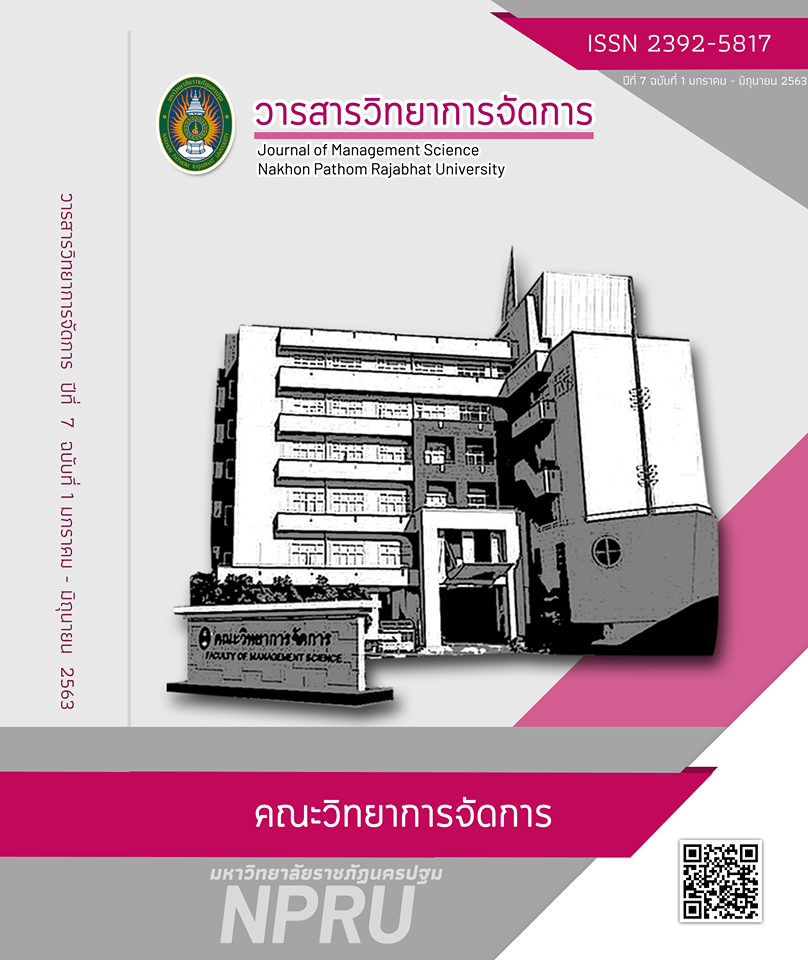Guidelines for improving the loyalty of Chinese tourists in Thailand
Main Article Content
Abstract
This thesis is intended to 1. Study the factors that influence the way to develop the loyalty of Chinese tourists in Thailand and 2. Find ways to improve the loyalty of Chinese tourists in Thailand. The example used in this research is 400 Chinese tourists who travel repeatedly in Thailand. Key informant are 5 Chinese tour operators in Thailand. Inquire about the development guidelines for repeat tourism of Chinese tourists in Thailand. By bringing the results from quantitative research into the study before conducting an in-depth interview. Data collection tools. Namely, questionnaires, statistics used in data analysis, including percentage, mean, standard deviation, One-way analysis of variance and multiple regression analysis.
The research found that
1. Marketing mix Affecting the loyalty of Chinese tourists in Thailand. The results showed that the marketing mix of products and marketing promotion had statistically significant results. With a coefficient of 0.66 and 0.44. The equation has 27 percent predictive power and can be written as an equation as follows.
Y = 2.42 + 0.66 Products * +0.34 Price +0.19 Place +0.44 Promotion*
2. Guidelines for improving the loyalty of Chinese tourists in Thailand can be concluded that the development of the loyalty of Chinese tourists in Thailand Must be born from understanding And good relationships. In the field of telecommunications services Security Most Chinese tourists are already ready to come to Thailand. Development in the facility and safety point Will help build confidence And the impression of tourism And telling impressions to relatives And the next friend
Article history : Received 28 April 2019
Revised 9 June 2019
Accepted 11 June 2019
SIMILARITY INDEX = 3.93 %
Article Details
The views and opinions of the article appearing in this journal are those of the author. It is not considered a view and responsibility of the editorial staff.
References
กระทรวงการท่องเที่ยวและกีฬา. (2561). สรุปสถานการณ์นักท่องเที่ยว มกราคม-ธันวาคม [ออนไลน์] ค้นเมื่อ 10 กรกฎาคม 2561 จาก http://www.tourism.go.th/uploades/Stat/2065.pdf. .
ซิน หลิว.(2556).แนวทางการตลาดสำหรับบริษัทตัวแทนการท่องเที่ยวไทย เพื่อรองรับนักท่องเที่ยวชาวจีนแบบอิสระ.วารสารวิทยาลัยบัณฑิตศึกษาการจัดการ มหาวิทยาลัยขอนแก่น. 6 (2) :70-90.
ธีรพงศ์ เที่ยงสมพงษ์. (2551). โมเดลเชิงสาเหตุของความจงรักภักดีต่อการใช้บริการสถานีบริการน้ำมันของลูกค้าในกรุงเทพมหานคร. สารนิพนธ์ปริญญาบริหารธุรกิจมหาบัณฑิต สาขาวิชาการตลาด บัณฑิตวิทยาลัย มหาวิทยาลัยศรีนครนิทรวิโรฒ.
ธีรพันธ์ โล่ห์ทองคำ. (2547). ความภักดีของลูกค้า. [ออนไลน์] ค้นเมื่อ 31 สิงหาคม 2561 จาก http://www.nidambe11.net/ekonomiz/2004q4/article2004nov30p5.htm
นรพรรณ โพธิพฤกษ์ จิตรา บุญตัน และทิพย์วดี โพธิ์สิทธิพรรณ.(2557). ปัจจัยส่วนประสมทางการตลาดที่มีผลต่อการตัดสินใจมาท่องเที่ยวจังหวัดเชียงใหม่ของนักท่องเที่ยวชาวจีน.วารสารวิชาการมหาวิทยาลัยฟาร์อีสเทอร์น. 7 (2).132-142.
บุญเลิศ จิตตั้งวัฒนา (2549) .การจัดนำเที่ยวและรายการนำเที่ยวภาคเหนือตอนบน.กรุงเทพมหานคร : เพรส แอนด์ ดีไซน์.
โพสต์ทูเดย์. (2561). ต่างชาติทะลักเที่ยวไทย ไตรมาสแรกกว่า10ล้านคนโต15.39%. [ออนไลน์] ค้นเมื่อ 2 ธันวาคม 2561 จาก https://www.posttoday.com/economy/news/548379
ศิริวรรณ เสรีรัตน์ ศุภร เสรีรัตน์ ปณิศา มีจินดา อรทัย เลิศวรรณวิทย์ ปริญ ลักษิตานน องอาจ ปทะวานิช และจิระวัฒน์ อนุชชานนท์ .(2552). การบริหารการตลาดใหม่. กรุงเทพมหานคร :Diamond In Business World.
สมิต สัชฌุกร. (2550). การต้อนรับและบริการที่เป็นเลิศ (Excellence service). (พิมพ์ครั้งที่ 5). กรุงเทพมหานคร : สายธาร.
สันติชัย เอื้อจงประสิทธิ์.(2549). การบริหารท่องเที่ยวเชิงกลยุทธ์.กรุงเทพมหานคร :บริษัทสามเจริญพาณิชย์.
สุชาริณี เที่ยงแท้ กุลกัญญา ณ ป้อมเพ็ชร์ และศิริจรรยา เครือวิริยะพันธ์. (2559). ปัจจัยส่วนประสมทางการตลาดบริการที่มีอิทธิพลต่อนักท่องเที่ยวชาวจีนที่เข้ามาท่องเที่ยวในประเทศไทย. วารสารครุศาสตร์อุตสาหกรรม. 15 (1) :203-210.
แสงเดือน รตินธร.(2555).ปัจจัยผลักดันและปัจจัยดึงดูดที่มีผลต่อนักท่องเที่ยวชาวจีนในการตัดสินใจเลือกมาท่องเที่ยวในประเทศไทย.วารสารวิชาการสมาคมสถาบันอุดมศึกษาเอกชนแห่งประเทศไทย (สสอท.).18 (2) :84-104.
Kotler, P. (2006). Marketing management. (13th ed.). Eaglewood Cliffs, NJ: Pearson education.
Kotler, P. and Keller, K. (2009) marketing management. (13th ed..) Englewood Cliffs, NJ: Pearson Education.
Schiffman.L.G and Kanuk.L.L (2010). Consumer Behavior. (10 th ed.) Pearson Prentice Hall.
Swarbrooke, J and Horner, S (1999) Consumer Behaviour in Tourism. Butterworth-Heinemann.
Yamane,T. (1976). Statistic: An introductory analysis. (2nd ed.). New York: Harper and Row.


